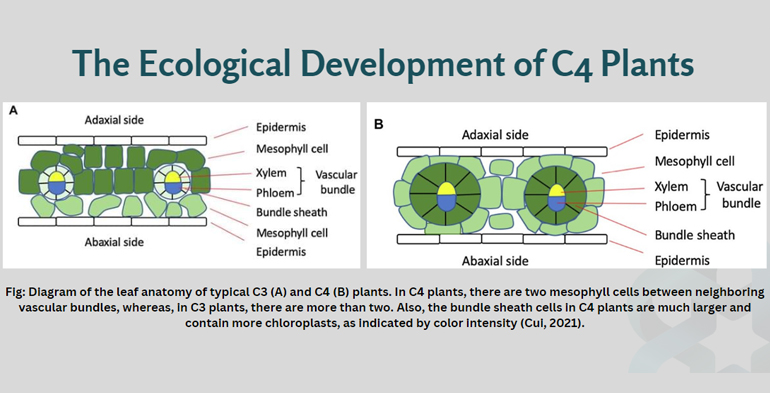
Dr. Md. Monirul Islam: C4 photosynthesis is a physiological phenomenon caused by a number of anatomical and metabolic components that work together to enhance CO2 concentrations near Rubisco while decreasing photorespiration. It developed numerous times independently, and C4 plants today dominate many biomes, particularly in the tropics and subtropics.
Converting a C3 plant to a C4 plant would require significant genetic and biochemical modifications, which are currently beyond our technological capabilities. However, researchers are actively studying the fundamental differences between C3 and C4 photosynthesis in order to understand how to engineer plants with more efficient carbon fixation pathways.
C3 plants, such as rice, wheat, and soybeans, fix carbon dioxide (CO2) directly through the Calvin cycle in their mesophyll cells. C4 plants, such as maize, sorghum, and sugarcane, use a specialized pathway that first fixes CO2 into a four-carbon compound in the mesophyll cells, and then transports it to bundle sheath cells for further fixation through the Calvin cycle. To convert a C3 plant to a C4 plant, the following modifications would need to be made:
Introduction of a C4 photosynthetic pathway: The genes and enzymes involved in the C4 pathway would need to be introduced into the C3 plant's genome. This would require a deep understanding of the regulatory mechanisms and metabolic pathways involved in C4 photosynthesis.
Modification of leaf anatomy: C4 plants have specialized leaf anatomy, with mesophyll and bundle sheath cells arranged in a concentric pattern to facilitate CO2 fixation and transport. The leaf anatomy of the C3 plant would need to be modified to accommodate the new pathway.
Optimization of biochemical pathways: The biochemical pathways involved in C4 photosynthesis are more complex than those of C3 photosynthesis, and would need to be optimized to ensure that they function efficiently in the modified plant.
Overall, converting a C3 plant to a C4 plant is a complex and challenging process that requires a deep understanding of plant physiology and genetics. While progress has been made in understanding the mechanisms of C4 photosynthesis, it is unlikely that we will be able to convert C3 plants to C4 plants in the near future.
Writer-Senior Scientist, ASRBC, ACI Seed





















